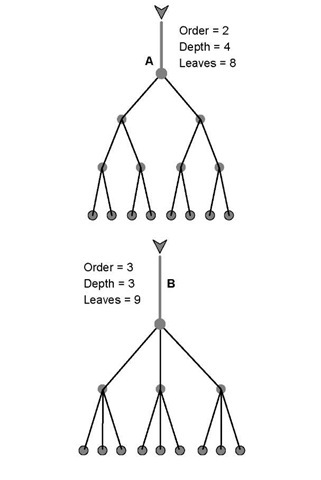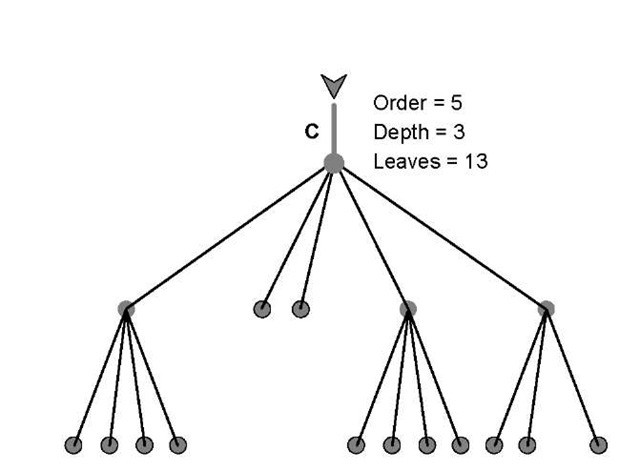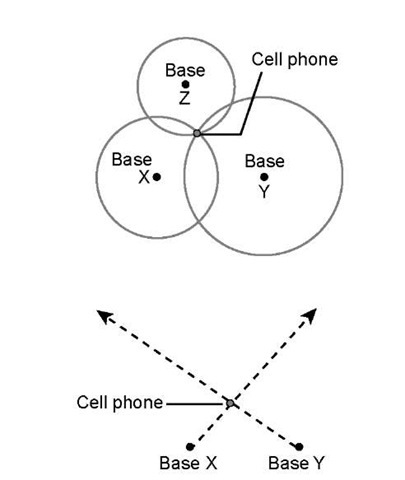Traveling-wave tube
A traveling-wave tube (TWT) is a specialized vacuum tube used in wireless communications, especially in satellite systems. The TWT can amplify or generate microwave signals. Two common types of TWT include the Klystron and the magnetron.
In the Klystron, a negatively charged cathode emits a beam of high-speed, high-energy electrons that travel through the cylindrical tube in straight lines to a positively charged anode. A coil is wound around the tube. When the coil is energized with a radio-frequency (RF) signal, the electrons in the beam alternately bunch up and spread out. In the magnetron, the electrons move in circles rather than in straight lines. The circular motion, produced by magnets at either end of the tube, allows the electrons to pick up energy over a greater distance.
Inside the TWT, the regions of high and low electron concentration move along or around the tube in waves. When the tube is properly operating, some of the energy from the electrons is imparted to the signal in the coil. The result is amplification of the signal.
A TWT can be made to function as an oscillator by coupling some of the output back into the input. This configuration is called a backward-wave oscillator, because the feedback is applied opposite to the direction of movement of the electrons inside the tube. Such an oscillator can generate up to approximately 0.1 watt of signal power in the microwave range.
A parametric amplifier is a TWT amplifier that operates from a high-frequency alternating current (AC) power source, rather than the usual direct current (DC) source. Some characteristic of the circuit, such as its impedance, is made to vary with time at the power-supply frequency. Parametric amplifiers are useful because they generate very little internal noise. This makes it possible to obtain excellent sensitivity in receiving systems, minimizing data-transfer errors.
tree structure
A tree structure is an algorithm for placing and locating files (called records or keys) in a database. The algorithm finds data by repeatedly making choices at decision points called nodes. A node can have as few as two branches (also called children), or as many as several dozen. The structure is straightforward, but in terms of the number of nodes and children, a tree can be gigantic.
In a tree, records are stored in locations called leaves. This name derives from the fact that records always exist at end points; there is nothing beyond them. The starting point is called the root. The maximum number of children per node is called the order of the tree. The maximum number of access operations required to reach the desired record is called the depth. In some trees, the order is the same at every node and the depth is the same for every record. This type of structure is said to be balanced. Other trees have varying numbers of children per node, and different records might lie at different depths. In that case, the tree is said to have an unbalanced or asymmetrical structure.
The illustration shows three examples of tree structures. (Note that the portrayals are upside-down compared to real tree plants.) Structures A and B are balanced, and structure C is unbalanced. Roots are at the top, and are represented by arrows. Nodes are shown as gray dots. Children are solid black lines. Leaves are at the bottom. As the process moves toward the leaves and away from the root, children can branch out from a node, but children never merge into a node.
In a practical tree, there can be thousands, millions, or billions of nodes, children, leaves, and records. Not every leaf necessarily contains a record, but more than half do. A leaf that does not contain data is called a null. The trees shown here are simple enough to be rendered in two dimensions, but with some large databases, three dimensions are needed to clearly depict the structure.
Also see binary tree, B-tree, M-tree, quad tree, splay tree, and X-tree.
triangulation
Triangulation is a process by which the location of a radio transmitter can be determined by measuring either the radial distance, or the direction, of the received signal from two or three different points. Triangulation is sometimes used in cellular communications to pinpoint the geographic position of a user.
The drawings below illustrate the basic principle of triangulation. In the scenario shown by the top drawing, the distance to the cell phone is determined by measuring the relative time delays in the signal from the phone set to three different base stations. In the scenario shown by the bottom drawing, directional antennas at two base stations can be used to pinpoint the location of the cell phone.
Triangulation is difficult to carry out unless the person using the cell phone wants to be located. This might be the case, for example, in an emergency situation. Triangulation is the method by which the so-called 911 cell phones work.
Triangulation apparatus can be confused by the reflection of signals from objects such as large steel-frame buildings, water towers, communications towers, and other obstructions. For this reason, at least two independent triangulation determinations should be made to confirm the position of a cell phone or other radio transmitter.
A more sophisticated form of triangulation is used by the Global Positioning System (GPS).
trigger
A trigger (from the Dutch trekken, meaning to pull) is a lever which, when pulled by the finger, releases the hammer on a firearm. In a database, a trigger is a set of Structured Query Language (SQL) statements that automatically ”fires off” an action when a specific operation, such as changing data in a table, occurs. A trigger consists of an event (an INSERT, DELETE, or UPDATE statement issued against an associated table) and an action (the related procedure). Triggers are used to preserve data integrity by checking on or changing data in a consistent manner.
triplecast
A triplecast (TM) is the simultaneous broadcast of a program on television, radio, and an Internet site or channel. NetTalk Live! originated the term to describe its weekly program about the Internet. In addition to listening to or viewing the show on radio or television in the Dallas/Fort Worth area, you can ”tune in” from a Web site, Audionet, from which you can download a RealAudio player and listen to streaming sound as the show progresses.
Trivial File Transfer Protocol
Trivial File Transfer Protocol (TFTP) is an Internet software utility for transferring files that is simpler to use than the File Transfer Protocol (FTP) but less capable. It is used where user authentication and directory visibility are not required. TFTP uses the User Datagram Protocol (UDP) rather than the Transmission Control Protocol (TCP). TFTP is described formally in Request for Comments (RFC) 1350.
Trojan horse
In computers, a Trojan horse is a program in which malicious or harmful code is contained inside apparently harmless programming or data in such a way that it can get control and do its chosen form of damage, such as ruining the file allocation table on your hard disk. In one celebrated case, a Trojan horse was a program that was supposed to find and destroy computer viruses. A Trojan horse may be widely redistributed as part of a computer virus.
The term comes from Homer’s Iliad. In the Trojan War, the Greeks presented the citizens of Troy with a large wooden horse in which they had secretly hidden their warriors. During the night, the warriors emerged from the wooden horse and overran the city.
tropospheric propogation
Radio waves can propagate over the horizon when the lower atmosphere of the earth bends, scatters, and/or reflects the electromagnetic fields. These effects are collectively known as tropospheric propagation, or tropo for short. Tropospheric propagation can affect wireless communications, sometimes enhancing the usable range, but also compounding interference problems.
The most well-known form of tropo is called bending. Air reduces radio-wave propagation speed compared with the speed in a vacuum. The greater the air density, the more the air slows the waves, and thus the greater is the index of refraction. The density and index of refraction are highest near the surface, and steadily decrease with altitude. This produces a tendency for radio waves at very-high frequencies (VHF, 30 to 300 MHz) and ultra-high frequencies (UHF, 300 MHz to 3 GHz) to be refracted toward the surface. A wave beamed horizontally can follow the curvature of the earth for hundreds of miles.
The lower atmosphere scatters electromagnetic radiation over a vast range, including radio wavelengths. This effect is known as tropospheric scatter, or troposcatter. In general, troposcatter is most pronounced at UHF and microwave radio frequencies (300 MHz and above). A radio wave beamed slightly above the horizon can be scattered at altitudes up to several miles, making over-the-horizon communication possible. The greatest communications range can be realized over flat land or over water. Scattered waves are weak, so high-power transmitters and sensitive receivers are necessary.
A less common, but often dramatic, form of tropo is called ducting or duct effect. This occurs when there is a defined, horizontal boundary between air masses having different densities. When a cool air mass is overlain by a warm air mass, as is the case along and near warm fronts and cold fronts, radio waves at VHF and UHF are reflected at the boundary if they strike it at a near-grazing angle from beneath (within the cooler air mass). Because radio waves are also reflected from the earth’s surface, the result can be efficient propagation for hundreds or, in some cases, upwards of 1,000 miles, as the waves alternately bounce off the frontal boundary and the surface. Ducting can allow long-distance radio reception in the frequency-modulation (FM) broadcast band between 88 and 108 MHz. It can also affect the lower VHF television channels if receiving antennas (rather than cable networks) are used.
true color
True color is the specification of the color of a pixel on a display screen using a 24-bit value, which allows the possibility of up to 16,777,216 possible colors. Many displays today support only an 8-bit color value, allowing up to 256 possible colors.
The number of bits used to define a pixel’s color shade is its bit-depth. True color is sometimes known as 24-bit color. Some new color display systems offer a 32-bit color mode. The extra byte, called the alpha channel, is used for control and special effects information.
true power
True power is the power manifested in tangible form such as electromagnetic radiation, acoustic waves, or mechanical phenomena. In a direct current (DC) circuit, or in an alternating current (AC) circuit whose impedance is a pure resistance, the voltage and current are in phase, and the following formula holds:
where P is the power in watts, Erms is the root-mean-square voltage in volts, and Irms is the rms current in amperes. But in an AC circuit whose impedance consists of reactance as well as resistance, the voltage and current are not in phase. This complicates the determination of power.
In the absence of reactance, this voltage-current product represents true power. But when there is reactance in an AC circuit, the product ErmsIrms is larger than the true power, and is known as apparent power.
The vector difference between the apparent and true power is called reactive power, and represents energy alternately stored and released by inductor and/or capacitor.
TrueType
Created at Apple Computer, TrueType was designed to fill the need for an optimized, scalable font format. The format uses hinting, a technique that preserves a font’s design, even at a small scale or on a display with low resolution. It was initially developed in response to the technical limitations of Adobe’s Postscript and Type 1 font formats. TrueType was first introduced in the Macintosh System 7 operating system in 1990. A year later, Apple licensed TrueType to Microsoft, and it was introduced in their Windows 3.1 operating system. After making some performance improvements to the format, they released version 1.5 in Windows NT 3.1, and have continued to update the format.
In order to view and print TrueType fonts on a computer, two components are necessary: the actual TrueType font file (with the extension TTF) and the TrueType raster graphics. The rasterizer is built into Windows and Mac operating systems.
If you use TrueType fonts on a Web page or in Word document, it is possible to embed them into the file, so that your fonts will still be viewable by people who do not have that font installed on their machine. Also keep in mind that the Macintosh and Windows versions of TrueType fonts are not compatible. When downloading TrueType fonts from the Internet (such as from a free fonts Web site), you must select the Mac or PC version. TrueType Font converters are available if a TrueType font is only available for one platform.
Microsoft’s most recent font development is called OpenType. This font format ensures that fonts are compatible across the Windows and Apple Macintosh platforms and encompasses Adobe’s Type 1 and PostScript technologies.
truncate
To truncate is to shorten by cutting off. In computer terms, when information is truncated, it is ended abruptly at a certain spot. For example, if a program truncates a field containing the value of pi (3.14159265…) at four decimal places, the field would show 3.1415 as an answer. This is different from rounding, which would result in the answer of 3.1416.
For another example, consider a text entry field in an electronic form. If a program limits the size of the field to 255 characters, it may allow you to continue typing past the maxiumum number of characters. However, when the information is submitted or saved, the program truncates the data to the first 255 characters and any additional characters are disregarded.
Several operating systems or programming languages use truncate as a command or function for limiting the size of a field, data stream, or file. Linux includes a truncate command for rounding integers.
trunk
In telephone systems, a trunk is a line that carries multiple voice or data channels between two telephone exchange switching systems. In digital communications, a trunk is often a T-carrier system.
trusted PC
The trusted PC is an industry ideal of a PC with built-in security mechanisms that place minimal reliance on the user or administrator to keep a PC and its peripheral devices secure. Trusted personal computing devices are being developed that maximize the security of individual computers through hardware and operating system-based mechanisms rather than through add-in programs and policies. To that end, security mechanisms are being built into chips, chipsets, and motherboards, among other things, because industry consensus is that hardware-based mechanisms are inherently more trustworthy than those created with software.
The Trusted Computing Platform Alliance (TCPA) was formed in October 1999 by Compaq, HP, IBM, Intel and Microsoft. TCPA, whose membership now includes more than 140 companies, states as its goals: ”To develop a specification, based on the collaboration of PC industry platform, operating system, application, and technology vendors, that delivers a set of hardware and operating system security capabilities that customers can use to enhance the trust and security in their computing environments.”
Once effective mechanisms are built into the actual computer hardware, security will not be as dependent upon the vigilance of individual administrators as it has been in the past. If the trusted PC works the way it should, an inexperienced or lackadaisical administrator won’t be able to unwittingly compromise system or network security through inefficient policies. The idea of a ”trusted PC” is similar to the trust relationships that can be set up between networked computers to allow the terminals involved varying degrees of access to each other’s data, depending on their requirements and level of trust. The new trusted PC uses the word in a different sense, in that its ”trust” is based on hard-wired security—somewhat like trusting children to stay out of the cookie jar because it is locked in a safe.
tuple
1) In programming languages, such as Lisp, Python, Linda, and others, a tuple (pronounced TUH-pul) is an ordered set of values. The separator for each value is often a comma (depending on the rules of the particular language). Common uses for the tuple as a data type are (1) for passing a string of parameters from one program to another, and (2) representing a set of value attributes in a relational database. In some languages, tuples can be nested within other tuples within parentheses or brackets or other delimiters. Tuples can contain a mixture of other data types.
Here’s an example of a tuple that emphasizes the different data types that may exist within a tuple data type: 17,*,2.49,Seven
The above example is sometimes referred to as a 4-tuple, since it contains four values. An n-tuple would be one with an indeterminate or unspecified number of values.
2) A tuple is analogous to a record in nonrelational databases.
The term originated as an abstraction of the sequence: single, double, triple, quadruple, quintuple,… n-tuple. Tuple is used in abstract mathematics to denote a multidimensional coordinate system.
Tux
Tux, the penguin, is the generally accepted official logo for the Linux operating system. Linus Torvalds, the creator of Linux, chose Larry Ewing’s design simply because he likes penguins. It is said that the name Tux was the winning entry in the ”Let’s Name The Penguin While Linus Is Away Contest” with the ”T” standing for Torvald and the "U" and ”X” for Linux.



